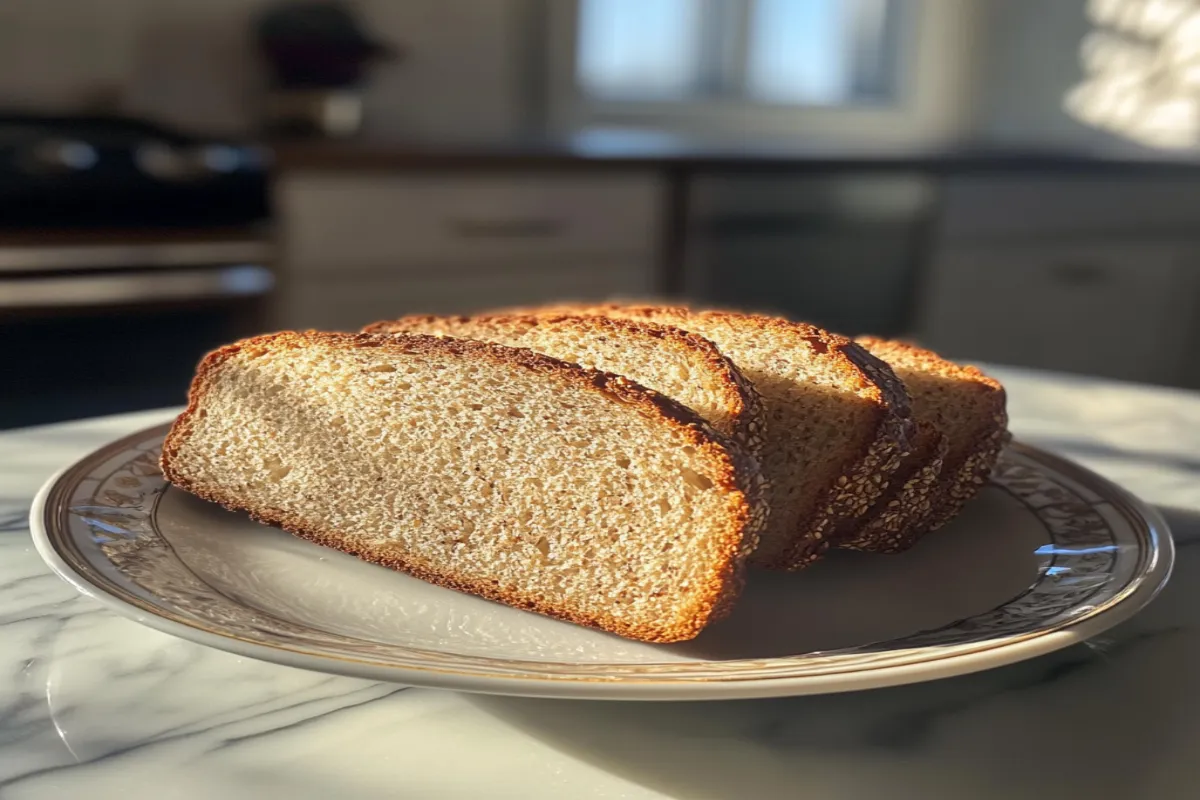Ezekiel bread is a sprouted grain bread that has gained popularity due to its health benefits and unique origins, which trace back to the Bible. This type of bread is not only nutritious but also aligns with many dietary preferences, including vegan and dairy-free lifestyles. In this article, you’ll learn everything about Ezekiel bread and how to make it at home. Furthermore, you will discover its unique nutritional advantages and the benefits of using sprouted grains.
What is Ezekiel Bread?
Ezekiel bread is a type of bread made from sprouted whole grains and legumes, inspired by the Biblical verse Ezekiel 4:9, which describes a recipe using wheat, barley, beans, lentils, millet, and spelt. Unlike most conventional bread, Ezekiel bread contains no refined flour and is crafted with a combination of sprouted grains, which contributes to its nutritional density. Moreover, the combination of grains and legumes provides a complete protein profile, making it highly nutritious.
The main ingredients include:
- Wheat
- Barley
- Spelt
- Millet
- Lentils
The use of sprouted grains makes Ezekiel bread different from other types of bread, both in terms of texture and health benefits. Learn more about how sprouted grains contribute to better nutrition.
Benefits of Ezekiel Bread
High Nutritional Value
Ezekiel bread is packed with protein, fiber, and a wide range of essential nutrients, making it an excellent choice for those seeking a healthy bread alternative. The sprouted grains improve digestibility and enhance the absorption of nutrients compared to traditional bread. Additionally, the combination of multiple grains and legumes provides a variety of vitamins and minerals that are beneficial for overall health.
Benefits of Sprouted Grains

- Improved Digestibility: Sprouting breaks down the starches in grains, making it easier for the body to digest. This process also reduces anti-nutrients like phytic acid, which can inhibit mineral absorption. Therefore, sprouted grains are more readily absorbed by the body.
- Enhanced Nutrient Absorption: Sprouted grains have increased levels of vitamins, especially B vitamins, and minerals like iron and zinc. For more information on the process of sprouting grains and its benefits, refer to The Spruce Eats – Sprouting Grains Guide.
Suitable for Certain Diets
Ezekiel bread is ideal for those following a vegan, dairy-free, or no-added-sugar diet. Its wholesome ingredients provide a balanced nutritional profile without any unnecessary additives. Furthermore, it is a nutrient-dense option compared to refined bread, making it suitable for anyone looking for healthier alternatives.
Ingredients Breakdown
Overview of the Key Ingredients
- Wheat, Spelt, Barley, Millet, Lentils: These are the main components of Ezekiel bread, each contributing unique nutrients and flavors to the final product. Consequently, each ingredient plays a significant role in providing a balanced nutrient profile.
Why Sprouted Grains Are Used
Sprouted grains are used because they offer improved nutrition and digestibility. The sprouting process increases enzymes that aid in breaking down complex carbohydrates and proteins, making them easier on the stomach. In addition, sprouting enhances the nutritional value of the grains, providing more vitamins and minerals.
Nutritional Profile of Each Ingredient
Each ingredient provides different nutrients:
- Wheat: High in fiber and protein.
- Barley: Rich in fiber and minerals.
- Spelt: Contains a broader range of vitamins compared to modern wheat.
- Millet: Gluten-free and a good source of magnesium.
- Lentils: Provide additional protein and iron, which are essential for muscle and blood health.
How Ezekiel Bread Compares to Regular Bread
Nutrition Comparison
When compared to white and whole wheat bread, Ezekiel bread stands out because of its sprouted ingredients. It has more fiber, protein, and essential nutrients, making it a much healthier option. Furthermore, Ezekiel bread has no added sugars, unlike many conventional breads.
Health Benefits Comparison

- White Bread: Lacks fiber and is often made with refined flour, resulting in a lower nutritional value.
- Whole Wheat Bread: Contains more fiber than white bread, but not as many nutrients as Ezekiel bread due to the absence of sprouted grains. Therefore, while whole wheat bread is a healthier option compared to white bread, Ezekiel bread provides an even higher nutritional benefit.
Taste and Texture Differences
Ezekiel bread has a denser texture compared to regular bread. Its flavor is nutty and slightly sweet, thanks to the combination of sprouted grains and legumes. Additionally, the texture is more substantial, making it a filling and satisfying option.
Making Ezekiel Bread at Home
Step-by-Step Guide to Making Ezekiel Bread at Home
6.1 Gather Ingredients and Equipment
- Ingredients Needed: Wheat, barley, spelt, millet, lentils, water, salt, and honey (optional).
- Equipment Overview: Blender or food processor, bread pan, large mixing bowl, and measuring cups. Ensure you have all the necessary equipment to make the process smoother and more efficient.
6.2 Sprouting the Grains
- Rinse the grains and soak them in water for 8-12 hours.
- Drain the water and spread the grains out in a sprouting tray or jar.
- Allow the grains to sprout for 2-3 days, rinsing them twice daily. Ensure proper sprouting by keeping them moist but not waterlogged. Moreover, sprouting for the right amount of time is crucial for achieving the desired flavor and nutritional benefits.
6.3 Preparing the Dough
- After sprouting, blend the grains into a coarse mixture.
- Combine the mixture with salt and honey (if desired).
- Knead the dough until it is smooth and well-mixed. Additionally, kneading the dough thoroughly ensures an even distribution of ingredients, which is important for consistent texture.
6.4 Baking Instructions
- Preheat your oven to 350°F (175°C).
- Place the dough in a greased bread pan and bake for 45-50 minutes, or until a toothpick inserted in the center comes out clean. Be sure to monitor the baking time to prevent overcooking, which can make the bread too dry.
6.5 Storage Tips
- Store Ezekiel bread in an airtight container.
- Keep refrigerated for up to 5 days or freeze for longer storage. Proper storage ensures that the bread remains fresh and retains its nutritional value for a longer period.
Tips for Making Perfect Ezekiel Bread

- Common Mistakes to Avoid: Ensure proper sprouting; do not rush the sprouting process. Additionally, avoid using too much water when blending the grains, as this can make the dough too wet.
- Adjusting the Recipe: For a softer texture, add a tablespoon of olive oil to the dough. Moreover, you can experiment with different grains to create variations in flavor and texture.
- Gluten-Free Variation: Substitute with gluten-free grains like quinoa and amaranth. This option is ideal for those with gluten sensitivities.
Frequently Asked Questions (FAQs)
- What makes Ezekiel bread different from regular bread?
Ezekiel bread uses sprouted grains instead of refined flour, making it more nutritious and easier to digest. Additionally, the combination of grains and legumes provides complete protein. - Is Ezekiel bread gluten-free?
No, Ezekiel bread contains wheat, which has gluten. However, you can make a gluten-free version using other grains. - How long does it take to sprout the grains?
It typically takes 2-3 days to sprout the grains, depending on temperature and humidity. Proper sprouting is essential for maximizing the nutritional value of the bread. - Can I use a bread maker for Ezekiel bread?
Yes, you can use a bread maker, but ensure it has a setting for sprouted grain bread. - What is the best way to store homemade Ezekiel bread?
Store in the refrigerator or freeze for extended shelf life.
Health Considerations and Potential Drawbacks
Who Should Avoid Ezekiel Bread?
People with gluten intolerance or celiac disease should avoid Ezekiel bread unless a gluten-free version is made. Moreover, those with specific grain allergies should be cautious when consuming this bread.
High Carbohydrate Content
Ezekiel bread contains a significant amount of carbohydrates, which might not be suitable for individuals on low-carb diets. Therefore, it is important to consider your dietary needs before incorporating Ezekiel bread into your meals.
Cost of Ingredients
Sprouted grains and legumes may be more expensive compared to conventional flour. However, the nutritional benefits often justify the cost for those seeking a healthier bread option.
Delicious Ways to Enjoy Ezekiel Bread
- Toasted with Avocado: A simple, nutritious breakfast or snack.
- As a Sandwich Base: Use Ezekiel bread for a hearty and healthy sandwich.
- French Toast with Ezekiel Bread: Makes a flavorful, nutrient-dense version of traditional French toast. Additionally, adding cinnamon and honey enhances the natural flavors of the sprouted grains.
Conclusion
Ezekiel bread is a nutritious alternative to regular bread, with its blend of sprouted grains and legumes offering numerous health benefits. Making it at home allows you to control the ingredients and ensure a fresh, wholesome loaf. Try making Ezekiel bread at home to enjoy its health benefits and unique flavor. Additionally, experimenting with different grains and flavors can make the experience even more rewarding.
This comprehensive guide covers everything you need to know about making and enjoying Ezekiel bread at home. If you have any questions or need further tips, feel free to explore more about sprouting and baking for better health.

